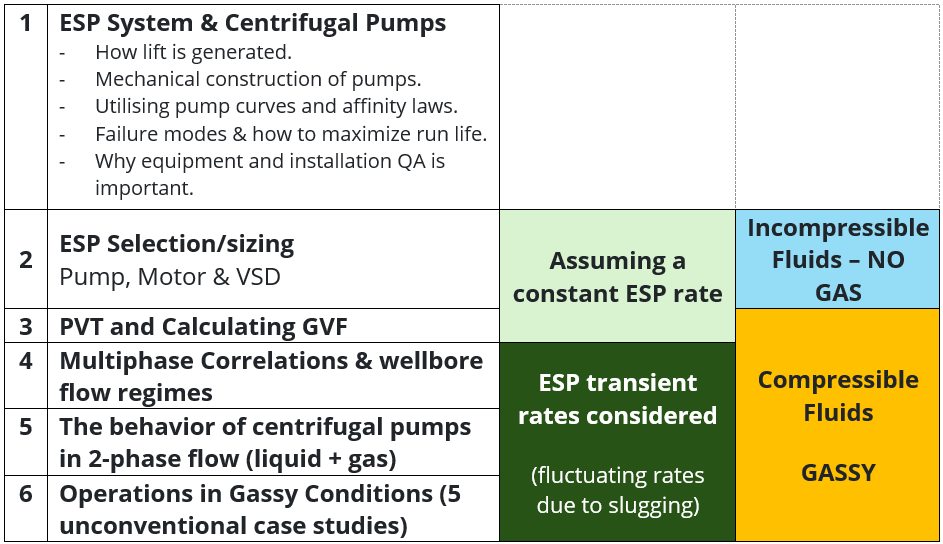ESP Design and Operation
Disciplines: Production and Operations
Course Description
This course provides the production engineer with the physics and petroleum engineering tools to understand the how and why of both ESP design and production optimization:
- Design: The engineer will acquire the engineering tools to forecast production with ESP simulations and generate cumulative production curves for a range of IPR curves and rising GOR which capture the effect of depletion over time.
- Production optimization: Utilizing real-time gauge data and production rate measurements to select the optimum frequency and choke settings to maximize drawdown, while managing the impact of gas.
With the increase in wells operating in saturated conditions, such as unconventional wells, the agenda provides a focus on ESP behavior in high GVF (gas void fractions) environments i.e. two-phase flow (liquid and gas) with an explanation of both the physics and a detailed review of five case studies, which cover both “gas locking” and slugging effects.
Course Agenda

Possible bonus chapters depending on time availability (notes will be provided anyway):
- Inflow monitoring; measuring IPR and skin in unconventional wells (or any well where depletion is present)
- ESP Completions
Each attendee will be provided with an electronic copy of all the slides, which include references to key technical papers for those who wish to continue reading. But more importantly, they will go away with a shared passion for the physics underlying ESP design and operations and maybe even some Eureka moments!
Learning Level
Intermediate to Advanced
Course Length
1 Day
Why Attend
To acquire an introduction and a deeper understanding of ESP design, operation, and optimization covering both the physics and case studies. This is therefore well suited to both production and operation professionals.
Who Attends
This course is designed for production and operation professionals, catering to both beginners and advanced users of ESPs. There will be a review of the basics to allow absolute beginners to come up a rapid learning curve.
CEUs
0.8 CEUs are awarded for this 1-day course.
Cancellation Policy
All cancellations must be received no later than 14 days prior to the course start date. Cancellations made after the 14-day window will not be refunded. Refunds will not be given due to no show situations.
Training sessions attached to SPE conferences and workshops follow the cancellation policies stated on the event information page. Please check that page for specific cancellation information.
SPE reserves the right to cancel or re-schedule courses at will. Notification of changes will be made as quickly as possible; please keep this in mind when arranging travel, as SPE is not responsible for any fees charged for cancelling or changing travel arrangements.
We reserve the right to substitute course instructors as necessary.
Instructor

Lawrence Camilleri has 40 years of experience in oil field production operations and is an expert in artificial lift, completions, and reservoir engineering (PTA & RTA). While at Schlumberger, he held a wide range of positions ranging from field and application engineer to in-house consultant for operators and most recently Global Artificial Lift Domain Head for Schlumberger, the most senior technical role within the Artificial Lift division. In August of 2021, he founded his consultancy business, Camilleri & Associates, focusing on production optimization, or as he likes to say, “completing and operating winning wells”. He has published 22 SPE conference papers and 3 patents covering all aspects of ESP operation such as inflow characterization and advanced completions. He was an SPE Distinguished Lecturer for 2019/2020 on production optimization. Throughout his publications, there are three recurring themes:
- Impact of gas on ESP operations, his work explains how operators can use real-time data to distinguish between head degradation, slugging, and “gas locking” and thereby improve designs and uptime. These techniques are essential for unconventional wells producing in saturated conditions.
- Utilization of real-time data for production optimization, which was the subject of his distinguished lecturer presentation. He showed how real-time data can be used to improve ESP run life and uptime, reduce ESP power consumption, and perform inflow analysis.
- Integration of PTA and RTA (inflow) with Artificial Lift (Outflow); for instance measurement of skin utilizing PTA in unconventionals.
19 Aug 2024
The Woodlands, Texas, USA
Held in conjunction with SPE Artificial Lift Conference and Exhibition - Americas
Before 23 July
USD 550 Member
USD 750 Nonmember
23 July-12 August
USD 650 Member
USD 850 Nonmember
After 12 August
USD 750 Member
USD 950 Nonmember
Questions?
trainingcourses@spe.org
